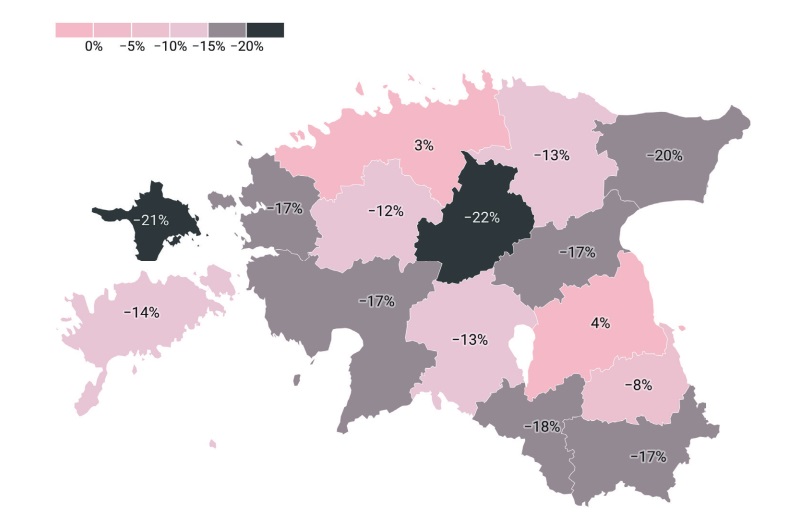The future of accessibility of local public services. Trends and scenarios up to 2050
In Estonia, there is a dense main local public services network, which means the accessibility of services is high compared to other European countries.
The vast majority of Estonian residents (67–83%, depending on the service) can walk to their nearest service point, if we count walking distance to be up to 3 km (2 km for kindergartens) (see figure).

Figure. How many people in the service target group live within a 10 or 30 minute drive (A) and up to X km (B) from the service point?
However, the location of a service point near one’s home does not guarantee its actual usability. Although over 80% of children can reach their nearest kindergarten on foot within 10 minutes, 48% of children go to kindergartens that are located further away. The same tendency can be seen in school and general practitioner services – 45% of primary school pupils and 59% of secondary school students do not study at their nearest educational institution, and 63% of Estonia’s residents are not registered with the general practitioner closest to their home.
Such service migration stems from the desire to use higher quality or more suitable services than the options closer to home. Choices are also influenced by the actual availability of services close to home, such as the available places in the nearest kindergarten or on the patient list of the nearest general practitioner. Service migration can increase social stratification, as wealthier people have better opportunities to use services located further away. This puts a burden on more popular services and reduces the use of services close to home, making them more difficult to preserve.
More cooperation from municipalities will be required in the future. Although the 2017 administrative reform increased the territories of municipalities in Estonia, most of them remain small in terms of population – 89% of municipalities have fewer than 20,000 inhabitants, compared to the OECD average of 58%. The projected 10–20% population decline by 2050 in all counties except Harju County and Tartu County will lead to the loss of a critical number of service users in many places in Estonia. The number of school-age children is decreasing faster than the total population, which will also affect Harju and Tartu counties (see figure). In the future, service provision needs to be more flexible, with lower fixed costs and often extending across municipal borders.
The need for cooperation is also growing due to people’s multiple places of residency: In 2020, 12% of Estonia’s residents lived in two different places, which means that service planning must go beyond local government borders. Cooperation could be fostered by agreeing on common service standards; if necessary, by setting in law an obligation to cooperate if the number of service users in a municipality falls below a certain critical level, as has been done in Finland and Denmark.

Figure. Projected population change: 2025–2050
Source: Statistics Estonia, Table RV085

Figure. Projected population change up to 2050: age group 5–14 (conventionally primary school), change compared to 2024
Source: Statistics Estonia, Table RV084
There is a global trend to consolidate multiple public services into one physical location to achieve economies of scale, improve service use and strengthen local community life. In sparsely populated areas, community centres are often built near kindergartens and schools, where, for example, remote work offices, libraries, youth centres and cultural services are added. In Estonia, the co-location of services is currently still limited – there are only few municipalities where at least one third of service points accommodate two or more services at the same location.
In the future, successful services will be those delivered through the most appropriate channels: providing them via physical, digital or mobile channels depending on the situation and user needs. The signs of this are already there: public libraries offer support in using e-services and audio and e-books can be borrowed from the virtual bookshelf MIRKO. Mobile library buses in sparsely populated areas supplement the service. In general practice services, e-consultations and remote appointments are becoming more common in addition to face to face appointments. In youth centres, mobile youth work is being developed, allowing the service to reach places where there is no permanent youth centre.
Estonia’s municipalities are generally efficient, but their ability to provide quality services to residents has declined in recent years. Even if a municipality’s revenue is larger than that of some others, this does not increase its efficiency. However, where the population is denser, efficiency increases, which means that more sparsely populated municipalities are slightly less efficient on average. Therefore, merging sparsely populated municipalities in Estonia may not necessarily increase their efficiency under these conditions.
The gap in local government revenues is growing again. As a result of the administrative reform, the gap in revenues between the municipalities with the highest and lowest revenues decreased by half; however, by now, it has increased again considerably. The reason for the gap could be the end of merger subsidies as well as varying levels of economic development in regions, which brings more income tax revenue primarily to regions that are economically more active. Since there is a clear connection between revenue and service levels – 10% more income per resident means 4% higher level of service – the gap in income levels also increases variations in levels of service.
In the future, the following trends will have an impact on the provision of local public services:
- the population is ageing and, in most parts of Estonia, it is also decreasing
- the fragmentation of the information space fuels polarisation and makes the design of public services more difficult.
- digital development improves connectivity, but can deepen the divide between regions
- maintenance costs of existing service infrastructure are increasing
- local renewable energy supports the sustainability of public services in rural areas
- when planning public services, their economic efficiency and crisis resilience clash
- local services’ quality requirements and processes become more uniform
The scenario analysis highlighted two key regional policy decisions that have to be made:
1. We must choose between emphasising regional characteristics of services, or pursuing county-level standardisation in Estonia. On the one hand, it is important to support community initiative and the adaptation of services to local conditions; on the other hand, there is a need to reduce costs while maintaining quality and accessibility, which requires the organisation of services to be more standardised.
2. It is increasingly necessary to consider which service provision channel is best suited to specific conditions: a physical service point close by, a service centre further away with good public transport, demand-based local transport, remote or e-service, or a mobile service that visits periodically. It is not necessary to implement all solutions at once – it is important to adapt the accessibility of services according to the needs and possibilities of the region. For each option, the necessary accessibility conditions must be met; for example, a reliable internet connection for e-services, so that the service does not remain only on paper.

 An independent think tank at the Riigikogu
An independent think tank at the Riigikogu 